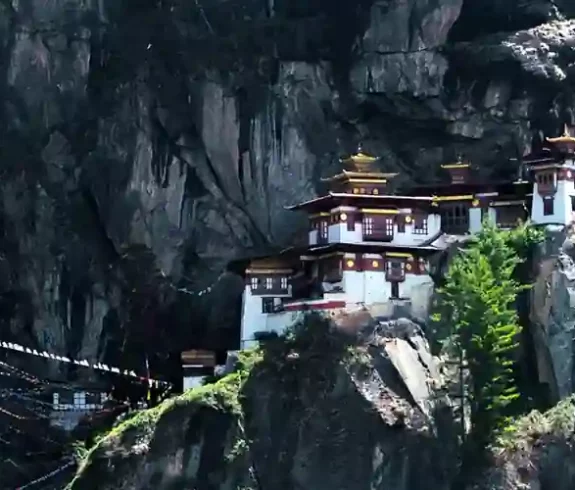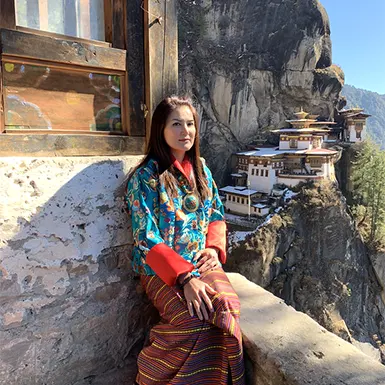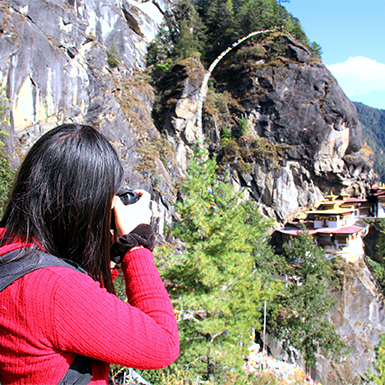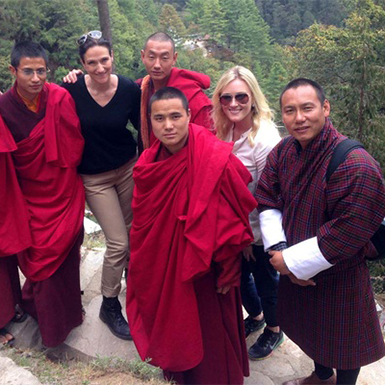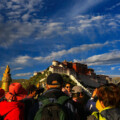Bhutan, a mystical land in the Himalayas, is a tapestry of age-old traditions and profound spirituality. Among the most revered landmarks in the Bhutanese landscape are its exquisite temples, dzongs, and shakhas. These sacred sanctuaries are not merely architectural marvels but living expressions of the Bhutanese people’s faith, history, and artistic ingenuity. Temples in Bhutan play a pivotal role in the daily lives of the Bhutanese, serving as places of worship, cultural centers, and community hubs.
The Bhutanese people, predominantly followers of Vajrayana Buddhism, hold these temples in high regard. They believe that these sacred spaces are imbued with divine energy and provide a gateway to spiritual enlightenment. Temples in Bhutan serve as places for solitary meditation and prayer and as vibrant centers of social interaction. These temples host festivals, rituals, and traditional performances, making them integral to community life. They foster community and cultural identity, connecting people to their roots and heritage.
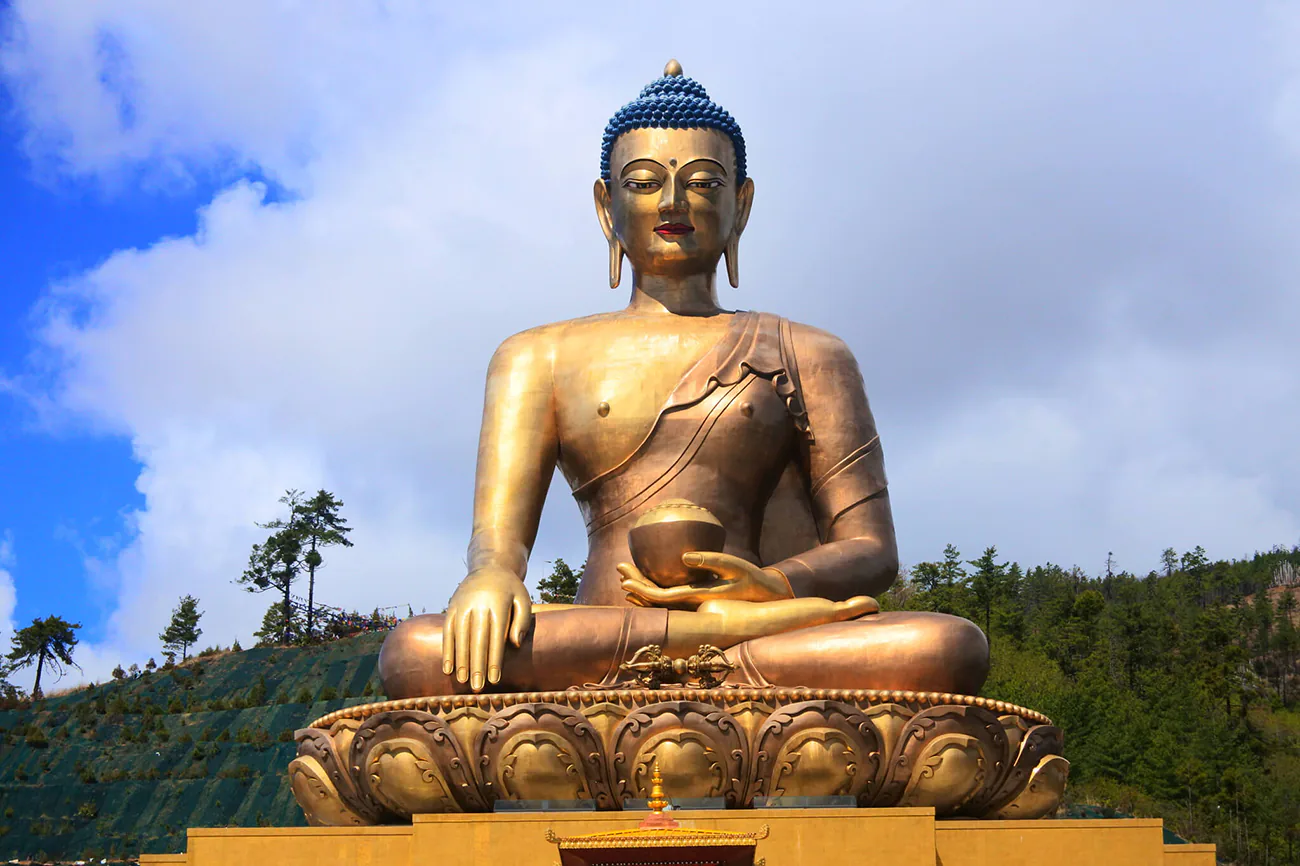
Buddhism in Bhutan: A Tapestry Woven into Temple Architecture
Buddhism is the cornerstone of Bhutanese culture and has profoundly influenced the country’s art, architecture, and way of life. With their design and layout deeply rooted in Buddhist philosophy, Temples in Bhutan actively create spaces that inspire reverence, contemplation, and spiritual growth.
- Dzongs: Fortresses of Faith: Dzongs, which often serve as religious and administrative centers, are imposing structures. Their strategic locations, typically overlooking valleys or perched on hilltops, offer breathtaking views of the surrounding landscape.
- Lhakhangs: Temples of the People: Lhakhangs are smaller temples scattered throughout Bhutan, often found in remote villages or nestled amidst nature’s embrace. They serve as local places of worship and community gathering spots.
- Chortens: Monuments of Devotion: Chortens, dome-shaped structures containing religious relics, are believed to emanate positive energy. You can often find chortens along roadsides, at mountain passes, and within temple complexes.
- Prayer Wheels: Symbols of Spiritual Practice: Devotees spin prayer wheels, cylindrical devices filled with mantras, as an act of devotion and meditation. Their rhythmic whirring creates a peaceful ambiance in temple courtyards.
Echoes of an Ancient Spiritual Legacy
The history of temples in Bhutan intertwines with the country’s spiritual evolution and cultural identity, making it a captivating tale. These sacred structures, known as dzongs and lhakhangs, have stood as silent witnesses to centuries of devotion, architectural innovation, and the unwavering faith of the Bhutanese people.
The History of Temple Construction in Bhutan: A Journey Through Time
- Early Beginnings (7th Century): Bhutan’s earliest temples date back to the 7th Century when Buddhism first arrived in the region. Kyichu Lhakhang in Paro, one of the oldest temples in Bhutan, is believed to have been built by the Tibetan king Songtsen Gampo.
- The Rise of Dzongs (17th Century): The 17th Century marked a pivotal era in Bhutanese temple construction, with the rise of dzongs – massive fortresses that served as religious and administrative centers. These imposing structures, strategically located on hilltops and riverbanks, symbolized Bhutan’s political and spiritual authority.
- Lhakhangs: Temples of the People: While dzongs exude grandeur, lhakhangs are smaller, more intimate temples scattered throughout Bhutan. Often built by local communities, these temples hold a special place in the hearts of the Bhutanese people, serving as gathering places for religious ceremonies and cultural events.
- Modern-Day Temples: Today, Bhutan continues to preserve and build new temples, ensuring its rich spiritual heritage remains vibrant for future generations. Contemporary temples often incorporate traditional architectural elements with modern innovations, creating aesthetically pleasing and functionally relevant spaces.
Key Figures in Bhutanese Buddhism and Their Contributions to Temple Construction
- Guru Rinpoche (Padmasambhava): Revered as the “Second Buddha,” Guru Rinpoche was pivotal in introducing Buddhism to Bhutan in the 8th Century. His teachings and spiritual legacy actively inspire the construction and design of many temples in Bhutan.
- Zhabdrung Ngawang Namgyal: The unifier of Bhutan in the 17th Century, Zhabdrung Ngawang Namgyal is credited with constructing numerous dzongs and lhakhangs across the country. His foresight and guidance laid the groundwork for Bhutan’s exceptional architectural and spiritual heritage.
- Local Lamas and Community Leaders: Instrumental in building and safeguarding Bhutan’s temples, local lamas and community leaders have played a pivotal role throughout history. Their dedication to preserving Bhutan’s religious heritage has ensured the continued vitality of these sacred spaces.
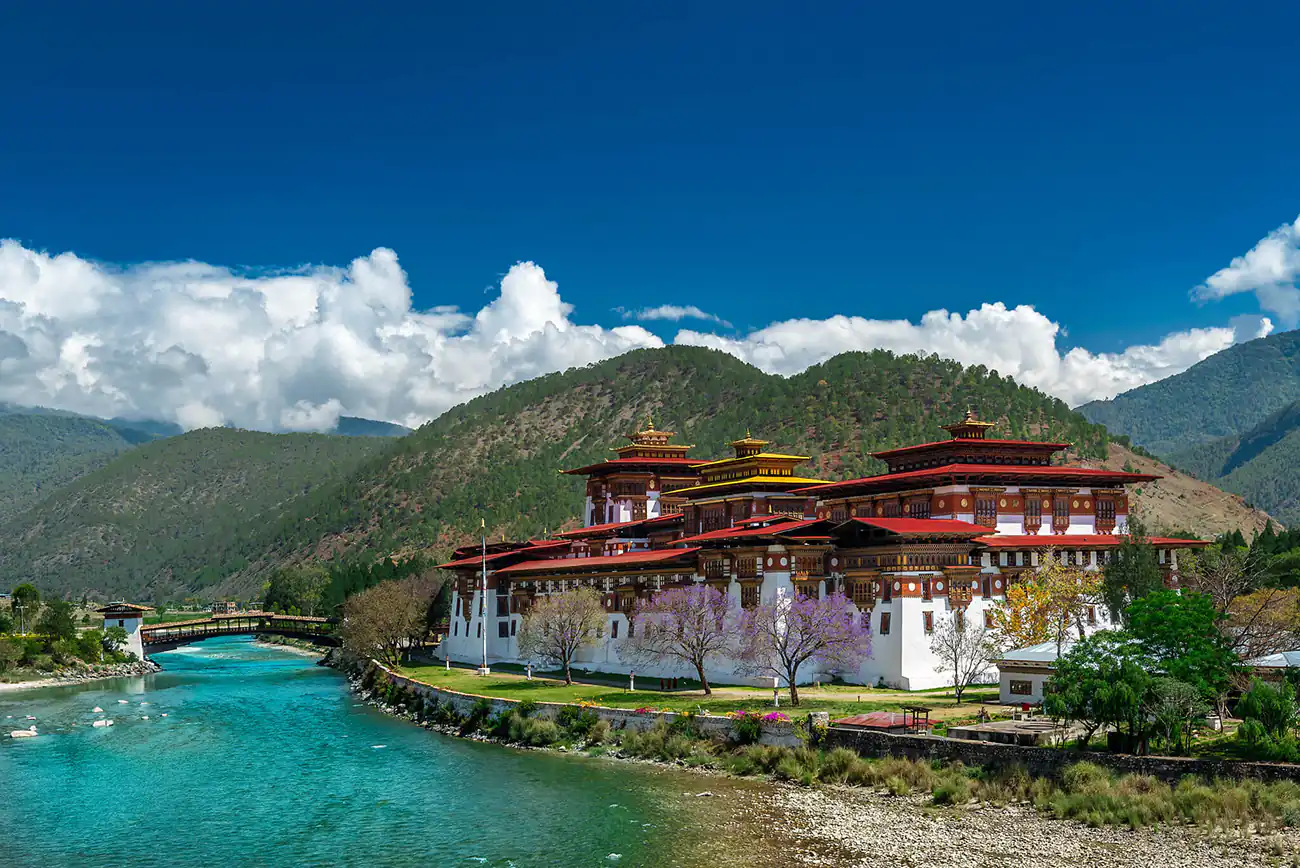
Architectural Splendor and Sacred Art
Temples in Bhutan, intricate in design and vibrant with artwork, actively reflect the country’s rich cultural heritage and deep-rooted spirituality. Beyond places of worship, dzongs and lhakhangs fulfill additional roles. They are architectural masterpieces, showcasing the harmonious blend of Buddhist traditions and local aesthetics.
Architectural Features of Bhutanese Temples: A Unique Fusion
Each element within Bhutanese temple architecture serves a symbolic purpose, harmoniously blending form and function.
- Dzongs: Guardians of Faith and Authority: Dzongs, often serving as both religious and administrative hubs, are imposing structures that command attention with their towering walls, intricate woodwork, and strategic hilltop or riverside locations. Their design speaks volumes about Bhutan’s history of defense and spiritual dominance.
- Lhakhangs: Sanctuaries of Intimate Devotion: Scattered throughout Bhutan, smaller temples known as lhakhangs often nestle in villages or hide amidst lush forests. While more straightforward in design than dzongs, their beauty is undeniable. They offer intimate spaces for personal worship and quiet reflection.
- Symbolism in Design: Bhutanese temples are rich in symbolic language. The colors, shapes, and motifs used in their construction and decoration hold specific meanings. Red represents power and protection, while the lotus flower symbolizes purity and enlightenment.
Interior Artwork: A Visual and Spiritual Feast
Entering a Bhutanese temple immerses one in a world of vibrant hues, intricate designs, and sacred symbolism.
- Murals: Painted Narratives: Artists adorn the walls of temples in Bhutan with elaborate murals depicting Buddhist deities, mythical creatures, historical events, and scenes from everyday life. These murals are visual tools for teaching Buddhist philosophy and preserving cultural traditions.
- Status: Divine Embodiment: Throughout Bhutanese temples, you’ll find statues of Buddha, bodhisattvas, and other important figures, often crafted from bronze or clay and adorned with meticulous detail. These statues serve as objects of veneration and reminders of Buddhist teachings.
- Thangkas: Art on the Move: Artists create thangkas, painted or embroidered scrolls depicting Buddhist deities and scenes from sacred texts. Monks often carry these portable works of art during their travels, using them as tools for meditation and teaching.
Sacred Journeys Through Time and Tradition
Bhutan, a Himalayan kingdom celebrated for its spiritual depth, is home to numerous awe-inspiring temples and monasteries. These sacred sites, known as dzongs and lhakhangs, beckon travelers with their architectural splendor, spiritual significance, and cultural richness.
Famous Temples in Bhutan: Where History and Spirituality Converge
- Paro Taktsang (Tiger’s Nest Monastery): A Cliffside Sanctuary: Clinging dramatically to a cliffside, the Tiger’s Nest Monastery stands as an iconic symbol of Bhutan. Legend tells of Guru Rinpoche, a revered Buddhist figure, who flew to this site on a tigress’s back and meditated in a cave. Today, pilgrims and visitors tour this sacred site to experience its breathtaking views and spiritual energy.
- Punakha Dzong: The Palace of Great Happiness Beckons: The majestic Punakha Dzong, or “Palace of Great Happiness,” stands proudly at the confluence of two rivers. It served as Bhutan’s capital until the mid-20th century. Its historical significance shines through its intricate woodwork, vibrant murals, and tranquil courtyards, offering a window into Bhutan’s rich cultural heritage.
- Kyichu Lhakhang: Whispers of Ancient Origins: As one of Bhutan’s oldest and most sacred temples, Kyichu Lhakhang dates back to the 7th century. Legend says the Tibetan king Songtsen Gampo built it to subdue a giant ogress. Its ancient architecture, serene ambiance, and sacred relics make it a cherished destination for locals and tourists alike.
- Chimi Lhakhang: The Temple of Fertility and Blessings: Dedicated to the Divine Madman, Drukpa Kunley, Chimi Lhakhang, also known as the fertility temple, draws couples seeking fertility blessings. This 15th-century saint, celebrated for his unconventional teachings and playful wisdom, adorned the temple with phalluses.
- Rinpung Dzong: A Fortress of Historical and Cultural Significance: The imposing Rinpung Dzong, meaning the Fortress of the Heap of Jewels, stands proudly in Paro. This historical structure once served as a defensive fortress and administrative center. Today, it houses government offices, a monastic body, and a museum that showcases Bhutan’s vibrant past.
Respectful Temple Visits in Bhutan: Etiquette Tips
- Dress Modestly: Embrace Bhutanese culture by dressing modestly and covering your shoulders and knees.
- Footwear Removal: Remove your shoes before entering the temple premises, as Bhutan customary.
- Quiet Contemplation: Respect the serene atmosphere by maintaining silence and avoiding disruptive behavior.
- Photography Etiquette: Always seek permission before photographing inside temples, as some areas may be restricted.
- Show Your Support: Consider making a small donation to contribute to the temple’s upkeep.
Where Spirituality and Community Converge
Beyond their stunning architecture, temples in Bhutan serve as vibrant hubs for spiritual growth, community bonding, and cultural festivities. These sacred spaces, known as dzongs and lhakhangs, intertwine the threads of Bhutanese life, weaving a tapestry of tradition and devotion.
Nurturing Bhutanese Spirituality
Temples in Bhutan extend far beyond their role as places of worship. They offer sanctuaries where individuals seek solace, guidance, and spiritual enrichment.
- Meditation and Prayer: These tranquil sanctuaries provide an ideal environment for meditation and prayer, allowing individuals to connect with their inner selves.
- Sharing Wisdom and Knowledge: Monks and lamas residing in temples share their wisdom through teachings and discussions, imparting valuable life lessons rooted in Buddhist philosophy.
- Deepening Spiritual Practices: Many temples in Bhutan host retreats and programs to facilitate spiritual growth and offer profound insights into existence.
Community Life Thrives in Bhutanese Temples
Temples in Bhutan act as vibrant community centers, fostering solid social connections and preserving cultural heritage.
- Festivals: A Kaleidoscope of Colors and Traditions: Bhutanese temples host many vibrant festivals yearly. Tshechus, religious festivals featuring masked dances and ancient rituals, are a highlight of the cultural calendar.
- Community Gatherings: A Place for Togetherness: Temples in Bhutan serve as meeting points for local communities, where people gather to discuss important matters, celebrate special occasions, and strengthen social bonds.
- Education and Preservation: Some temples house schools and libraries, providing educational opportunities for monks and lay people. They are essential in preserving Bhutan’s cultural heritage and transmitting knowledge across generations.
Festivals of Note in Bhutan’s Temples
- Paro Tshechu: Honoring Guru Rinpoche: Held at Paro Rinpung Dzong, this vibrant festival celebrates Guru Rinpoche’s life and features masked dances, sacred rituals, and the grand unveiling of a giant thangka (religious scroll).
- Punakha Drubchen: Remembering a Historic Battle: This festival reenacts a 17th-century battle, showcasing the courage and skill of Bhutanese warriors. It unfolds at Punakha Dzong with colorful processions and traditional performances.
- Thimphu Tshechu: Bhutan’s Grandest Celebration: The most significant festival in Bhutan, Thimphu Tshechu, takes place in the capital city and attracts thousands of visitors. It boasts a series of masked dances, religious ceremonies, and cultural exhibitions.
Exploring Bhutan’s Sacred Temples: A Mindful Traveler’s Guide
Are you planning to visit Bhutan’s awe-inspiring temples? This Himalayan kingdom offers many spiritual and cultural experiences, but approaching these sacred sites with respect and understanding is critical. This guide will help you make the most of your temple adventures in Bhutan.
Etiquette for Temple Visits in Bhutan
Respecting Bhutanese customs and traditions ensures a meaningful and enjoyable experience.
- Dress Respectfully: Choose modest attire that covers your shoulders and knees. Respecting the sacredness of temples and Bhutanese culture is essential during your visit. This action demonstrates your appreciation and understanding of the cultural and spiritual significance of temples in Bhutan.
- Remove Your Shoes: You must remove your shoes upon entering the temple, a common practice at religious sites in Bhutan.
- Ask Before You Snap: Ask permission before taking photos or videos inside the temples. Some areas might have restrictions, and it’s essential to respect the privacy of worshippers.
- Embrace the Silence: Maintain a peaceful and respectful atmosphere. Avoid loud conversations or disruptive behavior. Remember, temples are sanctuaries of peace and contemplation.
- Show Your Appreciation by Leaving a small donation in the designated boxes to support the temple. Your donation helps maintain these sacred spaces.
- Walk Clockwise: In Buddhism, move clockwise around a temple or chorten (stupa). This act is considered virtuous.
- Spin the Prayer Wheels: If you encounter prayer wheels, gently spin them clockwise as you pass. This action symbolizes the spreading of blessings and good fortune.
When to Visit Bhutan’s Temples
The best time for the Bhutan Tour depends on your preferences and interests.
- Spring (March-May): Enjoy pleasant weather, clear skies, and vibrant blooms. It’s a perfect time to hike to the iconic Paro Taktsang (Tiger’s Nest Monastery).
- Autumn (September-November): Autumn is another fantastic season in Bhutan, offering travelers comfortable temperatures and clear vistas. Autumn festivals, or techs, are a significant highlight of this period.
- Winter (December-February): While chilly, winter unveils Bhutan’s snowy landscapes and offers a unique perspective on temple life at its most tranquil.
Essential Considerations for Temple Visitors
- High Altitude: Bhutan’s mountainous terrain means some temples sit at high altitudes. If you’re susceptible to altitude sickness, acclimatize slowly and prioritize lower-altitude temples first.
- Travel Permits: Foreign tourists need a permit to visit Bhutan, typically arranged through a licensed tour operator.
- Local Guides: Your Cultural Compass: Hiring a local guide enhances your experience. They provide valuable insights into Bhutanese culture, history, and religious practices, enriching your temple visits.
Preserving Bhutan’s Sacred Legacy: Safeguarding Temples for Future Generations
With their intricate architecture and spiritual significance, temples in Bhutan transcend their role as mere historical relics. They stand as living monuments to the nation’s rich cultural heritage. However, these sacred sites face challenges that threaten their preservation. Understanding the challenges and supporting conservation initiatives is vital to preserving Bhutan’s cultural treasures for future generations.
Protecting Bhutan’s Architectural Treasures
The Bhutanese government actively works to preserve and maintain temples in Bhutan, collaborating with various organizations and local communities.
- Government Leads the Charge: The Department of Culture, a Ministry of Home and Cultural Affairs division is at the forefront of preserving Bhutan’s cultural heritage. They oversee conservation projects, implement restoration initiatives, and raise awareness about the importance of temple preservation.
- Communities Step Up: Local communities actively participate in maintaining their temples. They engage in cleaning campaigns, repair works, and fundraising events to support conservation efforts.
- International Partnerships: Bhutan collaborates with international organizations like UNESCO and other cultural institutions to gain access to technical expertise and financial support for temple preservation projects.
Overcoming Conservation Challenges
While substantial efforts are underway to protect Bhutan’s temples, several obstacles hinder conservation.
- Natural Disasters Threaten: Bhutan is vulnerable to earthquakes, floods, and landslides, which can significantly damage temple structures. The remote location of some temples further complicates restoration efforts.
- Resources Prove Limited: Financial constraints and a need for more skilled artisans pose challenges to undertaking comprehensive restoration projects.
- Modernization Impacts Authenticity: Modernization’s growing influence occasionally leads to inappropriate materials and techniques in temple repairs, potentially compromising the authenticity of the structures.
- Climate Change Accelerates Deterioration: Shifting climate patterns increase rainfall and humidity, accelerating the decay of wooden structures and murals within the temples.
Balancing Tradition and Progress
As Bhutan navigates the delicate balance between modernization and cultural heritage, the government finds ways to preserve temples in Bhutan while adapting to contemporary needs. Sustainable tourism emerges as a critical player, generating revenue for conservation while fostering cultural exchange and understanding.
